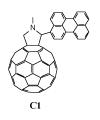As part of our interest in electron transfer reactions, we have used femtosecond spectroscopies to study the electron transfer dynamics in several electron-donor/fullerene bridged molecules synthesized in Fred Wudl's lab; for example, the fulleropyrolidine-perlyene derivative C1 whose structure is shown at left. This class of molecules is interesting because they
 have the potential to convert absorbed light energy to separated charges.
For this molecule, the hope was that in the excited state made by absorption
of a photon, perylene acts as an electron donor and the fullerene acts as
an electron acceptor, leading to charge separation. We were able to
prove that energy (Förster) transfer competes with electron transfer
in this molecule on an ultrafast time scale; in other words, even though charge
separation takes place in less than a picosecond, a significant fraction
of the photoexcitations on the perylene half of the molecule become electronic
excitations on the fullerene half of the molecule without any charge transfer.
Many groups are attempting to use related molecules in photovoltaic devices;
the usual figure of merit quoted is the ratio of the forward to reverse electron
transfer rates. Our results show, however, that the ratio of the electron
to energy transfer rates is a better choice. Clearly, the molecules
with the fastest charge separation are not necessarily the best candidates
for device applications if energy transfer is also a significant competitive
process on sub-picosecond time scales. See, e.g.,
have the potential to convert absorbed light energy to separated charges.
For this molecule, the hope was that in the excited state made by absorption
of a photon, perylene acts as an electron donor and the fullerene acts as
an electron acceptor, leading to charge separation. We were able to
prove that energy (Förster) transfer competes with electron transfer
in this molecule on an ultrafast time scale; in other words, even though charge
separation takes place in less than a picosecond, a significant fraction
of the photoexcitations on the perylene half of the molecule become electronic
excitations on the fullerene half of the molecule without any charge transfer.
Many groups are attempting to use related molecules in photovoltaic devices;
the usual figure of merit quoted is the ratio of the forward to reverse electron
transfer rates. Our results show, however, that the ratio of the electron
to energy transfer rates is a better choice. Clearly, the molecules
with the fastest charge separation are not necessarily the best candidates
for device applications if energy transfer is also a significant competitive
process on sub-picosecond time scales. See, e.g.,
I. B. Martini, B. Ma, T. Da Ros, R. Helgeson, F. Wudl and B. J. Schwartz, "Ultrafast Competition Between Energy and Charge Transfer in a Functionalized Electron Donor/Fullerene Derivative," Chem. Phys. Lett. 327(5-6), 253-62 (2000).
Á. Sastre, A. Gouloumis,
P. Vázquez, T. Torres, V. Doan, B. J. Schwartz, F. Wudl, L. Echegoyen,
and J. Rivera, "Phthalocyanine-Azacrown-Fullerene
Multicomponent System: Synthesis, Photoinduced Processes and Electrochemistry,"Org.
Lett. 1(11), 1807-10 (1999).